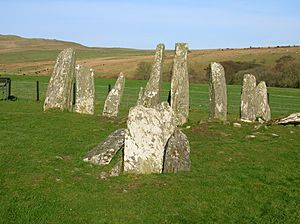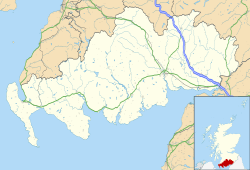Cairnholy facts for kids

Cairnholy I
|
|
| Location | Dumfries and Galloway |
|---|---|
| Coordinates | 54°51′33″N 4°18′34″W / 54.859239°N 4.309579°W |
| Type | Chambered tomb |
| History | |
| Periods | Neolithic |
| Site notes | |
| Ownership | Historic Scotland |
| Public access | Yes |
Cairnholy (also spelled Cairn Holy) is a special place in Scotland. It has two very old tombs from the Neolithic period, also known as the New Stone Age. These tombs are called "chambered tombs" because they have rooms or chambers inside. They are located about 4 kilometers east of a village called Carsluith in Dumfries and Galloway.
These ancient tombs are protected as "scheduled monuments" and are looked after by Historic Scotland. The name Cairnholy comes from the Gaelic words *Càrn na h-ulaidhe, which means 'cairn of the stone tomb'. A cairn is a pile of stones, often used to mark a burial place.
Contents
Exploring the Cairnholy Tombs
The Cairnholy tombs are found on a hillside. From here, you can see Wigtown Bay. They are right next to Cairnholy Farm. You can reach the site by driving down a small road, about 1 kilometer from the main A75 road. The two tombs are quite close to each other, only about 150 meters apart.
Today, both tombs are open to the sky. This is because many of their original covering stones were taken a long time ago. People used these stones to build walls for fields. Both tombs were partly dug up in 1949 by archaeologists Stuart Piggott and Terence Powell. The items they found are now kept in the National Museum of Scotland.
Cairnholy I: The Grand Tomb
Cairnholy I is the bigger and more detailed of the two tombs. It measures about 50 meters long and 15 meters wide. It has a grand, curved front wall called a façade. This façade created a special open area, like a courtyard, in front of the tomb. When archaeologists dug here, they found signs that several fires had been lit in this courtyard.
The tomb itself has two rooms or chambers. The first room, called the outer chamber, was entered through the façade. Inside, archaeologists found a piece of a special green stone axe. They also found pieces of Neolithic pottery and a sharp, leaf-shaped arrowhead. Later items found included different types of pottery and a flint knife.
The second room, the inner chamber, was built as a closed box. It was not connected to the outer chamber. It was probably covered by a very large stone slab resting on two tall stones. Inside this inner chamber, there was another small stone box. This box contained pieces of pottery and a stone carved with cup-and-ring marks.
Cairnholy II: The Smaller Tomb
Cairnholy II is located north of Cairnholy I. There's an old story that this tomb was the burial place of Galdus, a mythical Scottish king. The nearby farm is even named after this tomb. Cairnholy II is smaller, measuring about 20 meters long and 12 meters wide. It is less than 60 centimeters high.
Like Cairnholy I, many of its stones have been removed over time. However, you can still see two tall stones at the front of the tomb. There is also a very shallow, V-shaped courtyard at the front. This tomb also had two chambers. The back chamber had been disturbed before archaeologists arrived. The other chamber was also disturbed, but an arrowhead and a flint knife were found inside. Pieces of later pottery were also discovered.
Other Ancient Sites Nearby
About 160 meters east of Cairnholy farm, you can find the remains of a circular pile of stones, called a cairn. It's less than 15 centimeters high now. When stones were taken from it before 1849, human bones were found inside.
The area around Cairnholy also has many rocks with special carvings. These are called cup and ring marks. They are ancient designs carved into stones, often looking like small cups surrounded by rings.
Kirkdale Church Ruins
Around 700 meters to the west of Cairnholy, you can see the ruins of Kirkdale Church. This church was dedicated to Saint Michael. Kirkdale used to be its own parish (a church area). It joined with another parish called Kirkmabreck in 1618. The church ruins are surrounded by an old, overgrown burial ground.
See also
 In Spanish: Cairnholy para niños
In Spanish: Cairnholy para niños




